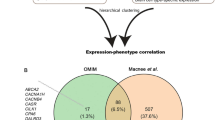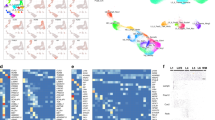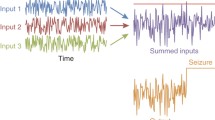Abstract
Seizure disorders affect a significant percentage of the population, and researchers worldwide continue to work toward a better understanding of what initiates, propagates, and results from aberrant and excessive neuronal excitation. During the past two decades, one aspect of this research effort has been to describe the effects of seizure activity upon neuronal gene expression, with hopes of identifying the molecular mechanisms that underlie subsequent changes in cell function and survival. Here we review this body of work from the perspective of how these gene profiling efforts have evolved, starting with one-by-one analyses of specific gene targets to the more recent use of DNA microarrays to survey literally thousands of genes simultaneously. With regard to the latter, we present some of our own work that suggests that molecular mechanisms contributing to normal brain development are reiterated during seizure-induced network reorganization.
Similar content being viewed by others
References
Coulter, D. A., McIntyre, D. C., and Loscher, W. 2002. Animal models of limbic epilepsies: what can they tell us? Brain Pathol. 12(2):240–256.
White, H. S. 2002. Animal models of epileptogenesis. Neurology. 59 (9 Suppl 5):S7–S14.
Goddard, G. V., McIntyre, D. C., and Leech, C. K. 1969. A permanent change in brain function resulting from daily electrical stimulation. Exp. Neurol. 25(3):295–330.
Racine, R. J. 1972. Modification of seizure activity by electrical stimulation. II. Motor seizure. Electroencephalogr. Clin. Neurophysiol. 32(3):281–294.
Racine, R. 1978. Kindling: the first decade. Neurosurgery. 3(2):234–252.
Wasterlain, C. G., Morin, A. M., and Jonec, V. 1982. Kindling: a pharmacological approach. Electroencephalogr. Clin. Neurophysiol. Suppl. 36:264–273.
Sloviter, R. S. and Damiano, B. P. 1981. Sustained electrical stimulation of the perforant path duplicates kainate-induced electrophysiological effects and hippocampal damage in rats. Neurosci. Lett. 24(3):279–284.
Sloviter, R. S. 1983. “Epileptic” brain damage in rats induced by sustained electrical stimulation of the perforant path. I. Acute electrophysiological and light microscopic studies. Brain Res. Bull. 10(5):675–697.
Swinyard, E. A. 1969. Laboratory evaluation of antiepileptic drugs. Review of laboratory methods. Epilepsia 10(2):107–119.
Squires, R. F., Saederup, E., Crawley, J. N., Skolnick, P., and Paul, S. M. 1984. Convulsant potencies of tetrazoles are highly correlated with actions on GABA/benzodiazepine/picrotoxin receptor complexes in brain. Life Sci. 35(14):1439–1444.
Campbell, K. A., Bank, B., and Milgram, N. W. 1984. Epileptogenic effects of electrolytic lesions in the hippocampus: role of iron deposition. Exp. Neurol. 86(3):506–514.
Pico, R. M. and Gall, C. M. 1994. Hippocampal epileptogenesis produced by electrolytic iron deposition in the rat dentate gyrus. Epilepsy Res. 19:27–36.
Nadler, J. V. 1981. Minireview. Kainic acid as a tool for the study of temporal lobe epilepsy. Life Sci. 29(20):2031–2042.
Cavalheiro, E. A. 1995. The pilocarpine model of epilepsy. Ital. J. Neurol. Sci. 16:33–37.
Ben-Ari, Y. and Cossart, R. 2000. Kainate, a double agent that generates seizures: two decades of progress. Trends Neurosci. 23(11):580–587.
Margerison, J. H. and Corsellis, J. A. 1966. Epilepsy and the temporal lobes. A clinical, electroencephalographic and neuropathological study of the brain in epilepsy, with particular reference to the temporal lobes. Brain 89(3):499–530.
Lowenstein, D. H. 2001. Structural reorganization of hippocampal networks caused by seizure activity. Int. Rev. Neurobiol. 45:209–236.
Sutula, T., Cascino, G., Cavazos, J., Parada, I., and Ramirez, L. 1989. Mossy fiber synaptic reorganization in the epileptic human temporal lobe. Ann. Neurol. 26(3):321–330.
Houser, C. R., Miyashiro, J. E., Swartz, B. E., Walsh, G. O., Rich, J. R., and Delgado-Escueta, A. V. 1990. Altered patterns of dynorphin immunoreactivity suggest mossy fiber reorganization in human hippocampal epilepsy. J. Neurosci. 10(1):267–282.
Isokawa, M., Levesque, M. F., Babb, T. L., and Engel, J., Jr. 1993. Single mossy fiber axonal systems of human dentate granule cells studied in hippocampal slices from patients with temporal lobe epilepsy. J. Neurosci. 13(4):1511–1522.
Franck, J., Pokorny, J., Kunkel, D. D., and Schwartzkroin, P. A. 1995. Physiologic and morphologic characteristics of granule cell circuitry in human epileptic hippocampus. Epilepsia. 36:543–558.
Tauck, D. and Nadler, J. 1985. Evidence of functional mossy fiber sprouting in hippocampal formation of kainic acid-treated rats. J.Neurosci. 5(4):1016–1022.
Sloviter, R. S. 1992. Possible functional consequences of synaptic reorganization in the dentate gyrus of kainate-treated rats. Neurosci. Lett. 137:91–96.
Wuarin, J. and Dudek, F. 1996. Electrographic seizures and new recurrent excitatory circuits in the dentate gyrus of hippocampal slices from kainate-treated epileptic rats. J. Neurosci. 16:4438–4448.
Ben-Ari, Y. 1985. Limbic seizure and brain damage produced by kainic acid: mechanisms and relevance to human temporal lobe epilepsy. Neuroscience 14(2):375–403.
Cronin, J. and Dudek, F. E. 1988. Chronic seizures and collateral sprouting of dentate mossy fibers after kainic acid treatment in rats. Brain Res. 474(1):181–184.
Mello, L. E., Cavalheiro, E. A., Tan, A. M., Kupfer, W. R., Pretorius, J. K., Babb, T. L., and Finch, D. M. 1993. Circuit mechanisms of seizures in the pilocarpine model of chronic epilepsy: cell loss and mossy fiber sprouting. Epilepsia 34(6):985–995.
Sonnenberg, J. L., Mitchelmore, C., Macgregor-Leon, P. F., Hempstead, J., Morgan, J. I., and Curran, T. 1989. Glutamate receptor agonists increase the expression of Fos, Fra, and AP-1 DNA binding activity in the mammalian brain. J. Neurosci. Res. 24(1):72–80.
Kaminska, B., Filipkowski, R. K., Zurkowska, G., Lason, W., Przewlocki, R., and Kaczmarek, L. 1994. Dynamic changes in the composition of the AP-1 transcription factor DNA-binding activity in rat brain following kainate-induced seizures and cell death. Eur. J. Neurosci. 6:1558–1566.
Hope, B. T., Kelz, M. B., Duman, R. S., and Nestler, E. J. 1994. Chronic electroconvulsive seizure (ECS) treatment results in expression of a long-lasting AP-1 complex in brain with altered composition and characteristics. J. Neurosci. 14(7):4318–4328.
Pennypacker, K. P., Thai, L., Hong, J-S., and McMillian, M. K. 1994. Prolonged expression of AP-1 transcription factors in the rat hippocampus after systemic kainate treatment. J. Neurosci. 14(7):3998–4006.
McNamara, J. O., Peper, A. M., and Patrone, V. 1980. Repeated seizures induce long-term increase in hippocampal benzodiazepine receptors. Proc. Natl. Acad. Sci. USA 77(5):3029–3032.
Valdes, F., Dasheiff, R. M., Birmingham, F., Crutcher, K. A., and McNamara, J. O. 1982. Benzodiazepine receptor increases after repeated seizures: evidence for localization to dentate granule cells. Proc. Natl. Acad. Sci. USA 79(1):193–197.
Shin, C., Pedersen, H. B., and McNamara, J. O. 1985. Gamma-aminobutyric acid and benzodiazepine receptors in the kindling model of epilepsy: a quantitative radiohistochemical study. J.Neurosci. 5(10):2696–2701.
Hong, J. S., Wood, P. L., Gillin, J. C., Yang, H. Y., and Costa, E. 1980. Changes of hippocampal metenkephalin content after recurrent motor seizures. Nature 285(5762):231–232.
Lason, W., Przewlocka, B., Stala, L., and Przewlocki, R. 1983. Changes in hippocampal immunoreactive dynorphin and neoendorphin content following intra-amygdalar kainic acid-induced seizures. Neuropeptides 3(5):399–404.
White, J. D. and Gall, C. M. 1986. Increased enkephalin gene expression in the hippocampus following seizures. NIDA Res. Monogr. 75:393–396.
Pitkanen, A., Beal, M. F., Sirvio, J., Swartz, K. J., Mannisto, P.T., and Riekkinen, P. J. 1989. Somatostatin, neuropeptide Y, GABA and cholinergic enzymes in brain of pentylenetetrazol-kindled rats. Neuropeptides 14(3):197–207.
Gall, C., Lauterborn, J., Isackson, P., and White, J. 1990. Seizures, neuropeptide regulation, and mRNA expression in the hippocampus. Prog. Brain Res. 83:371–390.
McGinty, J. F., Kanamatsu, T., Obie, J., and Hong, J. S. 1986. Modulation of opioid peptide metabolism by seizures: differentiation of opioid subclasses. NIDA Res. Monogr. 71:89–101.
Morgan, J. I., Cohen, D. R., Hempstead, J. L., and Curran, T. 1987. Mapping patterns of c-fos expression in the central nervous system after seizure. Science 237(4811):192–197.
Sonnenberg, J. L., Macgregor-Leon, P. F., Curran, T., and Morgan, J. I. 1989. Dynamic alterations occur in the levels and composition of transcription factor AP-1 complexes after seizure. Neuron 3:359–365.
Dragunow, M., Yamada, N., Bilkey, D. K., and Lawlor, P. 1992. Induction of immediate-early gene proteins in dentate granule cells and somatostatin interneurons after hippocampal seizures. Mol. Brain Res. 13(1-;2):119–126.
Gass, P., Herdegen, T., Bravo, R., and Kiessling, M. 1992. Induction of immediate early gene encoded proteins in the rat hippocampus after bicuculline-induced seizures: differential expression of KROX-24, Fos and Jun proteins. Neuroscience 48(2):315–324.
Elliott, R. C. and Gall, C. M. 2000. Changes in activating protein 1 (AP-1) composition correspond with the biphasic profile of nerve growth factor mRNA expression in rat hippocampus after hilus lesion-induced seizures. J. Neurosci. 20(6):2142–2149.
Sonnenberg, J. L., Rauscher III, F. J., Morgan, J. I., and Curran, T. 1989. Regulation of proenkephalin by Fos and Jun. Science. 246:1622–1625.
Gonzalez-Martin, C., de Diego, I., Crespo, D., and Fairen, A. 1992. Transient c-fos expression accompanies naturally occurring cell death in the developing interhemispheric cortex of the rat. Brain Res. Dev. Brain Res. 68(1):83–95.
Smeyne, R. J., Vendrell, M., Hayward, M., Baker, S. J., Miao, G. G., Schilling, K., Robertson, L. M., Curran, T., and Morgan, J. I. 1993. Continuous c-fos expression precedes programmed cell death in vivo. Nature 363(6425):166–169.
Kasof, G. M., Mandelzys, A., Maika, S. D., Hammer, R. E., Curran, T., and Morgan, J. I. 1995. Kainic acid-induced neuronal death is associated with DNA damage and a unique immediate-early gene response in c-fos-lacZ transgenic rats. J. Neurosci. 15(6):4238–4249.
Kaczmarek, L. 1992. Expression of c-fos and other genes encoding transcription factors in long-term potentiation. Behav. Neural Biol. 57(3):263–266.
Nikolaev, E., Kaminska, B., Tischmeyer, W., Matthies, H., and Kaczmarek, L. 1992. Induction of expression of genes encoding transcription factors in the rat brain elicited by behavioral training. Brain Res. Bull. 28:479–484.
Abraham, W. C., Mason, S. E., Demmer, J., Williams, J. M., Richardson, C. L., Tate, W. P., Lawlor, P. A., and Dragunow, M. 1993. Correlations between immediate early gene induction and the persistence of long-term potentiation. Neuroscience 56(3):717–727.
Dragunow, M. 1996. A role for immediate-early transcription factors in learning and memory. Behav. Genet. 26(3):293–299.
Gall, C. M. and Isackson, P. J. 1989. Limbic seizures increase neuronal production of messenger RNA for nerve growth factor. Science 245:758–761.
Lauterborn, J. C., Isackson, P. J., and Gall, C. M. 1994. Seizure-induced increases in NGF mRNA exhibit different time courses across forebrain regions and are biphasic in hippocampus. Exp. Neurol. 125:22–40.
Isackson, P. J., Huntsman, M. M., Murray, K. D., and Gall, C. M. 1991. BDNF mRNA expression is increased in adult rat forebrain after limbic seizures: temporal patterns of induction different from NGF. Neuron 6:937–948.
Dugich-Djordjevic, M. M., Tocco, G., Lapchak, P. A., Pasinetti, G. M., Najm, I., Baudry, M., and Hefti, F. 1992. Regionally specific and rapid increases in brain-derived neurotrophic factor messenger RNA in the adult rat brain following seizures induced by systemic administration of kainic acid. Neuroscience 47(2):303–315.
Humpel, C., Wetmore, C., and Olson, L. 1993. Regulation of brain-derived neurotrophic factor messenger RNA and protein at the cellular level in pentylenetetrazol-induced epileptic seizures. Neuroscience 53(4):909–918.
Gall, C., Lauterborn, J., Bundman, M., Murray, K., and Isackson, P. 1991. Seizures and the regulation of neurotrophic factor and neuropeptide gene expression in brain. Epilepsy Res. Suppl. 4:225–245.
Rocamora, N., Palacios, J. M., and Mengod, G. 1992. Limbic seizures induce a differential regulation of the expression of nerve growth factor, brain-derived neurotrophic factor and neurotrophin-3, in the rat hippocampus. Brain Res. Mol. Brain Res. 13(1-;2):27–33.
Merlio, J., Ernfors, P., Kokaia, Z., Middlemas, D., Bengzon, J., Kokaia, M., Smith, M., Siesjo, B., Hunter, T., Lindvall, O., and Persson, H. 1993. Increased production of the TrkB protein tyrosine kinase receptor after brain insults. Neuron 10(2):151–164.
Binder, D. K., Routbort, M. J., and McNamara, J. O. 1999. Immunohistochemical evidence of seizure-induced activation of trk receptors in the mossy fiber pathway of adult rat hippocampus. J. Neurosci. 19(11):4616–4626.
Roux, P. P., Colicos, M. A., Barker, P. A., and Kennedy, T. E. 1999. p75 neurotrophin receptor expression is induced in apoptotic neurons after seizure. J. Neurosci. 19(16):6887–6896.
Kokaia, Z., Bengzon, J., Metsis, M., Kokaia, M., Persson, H., and Lindvall, O. 1993. Coexpression of neurotrophins and their receptors in neurons of the central nervous system. Proc. Natl. Acad. Sci. USA 90(14):6711–6715.
Kokaia, M., Ernfors, P., Kokaia, Z., Elmer, E., Jaenisch, R., and Lindvall, O. 1995. Suppressed epileptogenesis in BDNF mutant mice. Exp. Neurol. 133(2):215–224.
Larmet, Y., Reibel, S., Carnahan, J., Nawa, H., Marescaux, C., and Depaulis, A. 1995. Protective effects of brain-derived neurotrophic factor on the development of hippocampal kindling in the rat. Neuroreport 6(14):1937–1941.
Croll, S. D., Suri, C., Compton, D. L., Simmons, M. V., Yancopoulos, G. D., Lindsay, R. M., Wiegand, S. J., Rudge, J. S., and Scharfman, H. E. 1999. Brain-derived neurotrophic factor transgenic mice exhibit passive avoidance deficits, increased seizure severity and in vitro hyperexcitability in the hippocampus and entorhinal cortex. Neuroscience 93(4):1491–1506.
Kang, H. and Schuman, E. 1995. Long-lasting neurotrophin-induced enhancement of synaptic transmission in the adult hippocampus. Science 267(5204):1658–1662.
Levine, E., Dreyfus, C., Black, I., and Plummer, M. 1995. Brain-derived neurotrophic factor rapidly enhances synaptic transmission in hippocampal neurons via postsynaptic tyrosine kinase receptors. Proc. Natl. Acad. Sci. USA 92(17):8074–8077.
Qian, Z., Gilbert, M. E., Colicos, M. A., Kandel, E. R., and Kuhl, D. 1993. Tissue-plasminogen activator is induced as an immediate-early gene during seizure, kindling and long-term potentiation. Nature 361(6411):453–457.
Yamagata, K., Andreasson, K. I., Kaufmann, W. E., Barnes, C.A., and Worley, P. F. 1993. Expression of a mitogen-inducible cyclooxygenase in brain neurons: regulation by synaptic activity and glucocorticoids. Neuron 11(2):371–86.
Yamagata, K., Sanders, L. K., Kaufmann, W. E., Yee, W., Barnes, C. A., Nathans, D., and Worley, P. F. 1994. rheb, a growth factor-and synaptic activity-regulated gene, encodes a novel Ras-related protein. J. Biol. Chem. 269(23):16333–16339.
Lyford, G. L., Yamagata, K., Kaufmann, W. E., Barnes, C. A., Sanders, L. K., Copeland, N. G., Gilbert, D. J., Jenkins, N. A., Lanahan, A. A., and Worley, P. F. 1995. Arc, a growth factor and activity-regulated gene, encodes a novel cytoskeleton-associated protein that is enriched in neuronal dendrites. Neuron 14(2):433–445.
Nedivi, E., Hevroni, D., Naot, D., Israeli, D., and Citri, Y. 1993. Numerous candidate plasticity-related genes revealed by differential cDNA cloning. Nature 363:718–721.
Naeve, G. S., Ramakrishnan, M., Kramer, R., Hevroni, D., Citri, Y., and Theill, L. E. 1997. Neuritin: a gene induced by neural activity and neurotrophins that promotes neuritogenesis. Proc. Natl. Acad. Sci. USA 94(6):2648–2653.
Hevroni, D., Rattner, A., Bundman, M., Lederfein, D., Gabarah, A., Mangelus, M., Silverman, M. A., Kedar, H., Naor, C., Kornuc, M., Hanoch, T., Seger, R., Theill, L. E., Nedivi, E., Richter-Levin, G., and Citri, Y. 1998. Hippocampal plasticity involves extensive gene induction and multiple cellular mechanisms. J. Mol. Neurosci. 10(2):75–98.
Adams, M. D., Kelley, J. M., Gocayne, J. D., Dubnick, M., Polymeropoulos, M. H., Xiao, H., Merril, C. R., Wu, A., Olde, B., Moreno, R. F., and et al. 1991. Complementary DNA sequencing: expressed sequence tags and human genome project. Science 252(5013):1651–1656.
Adams, M. D., Dubnick, M., Kerlavage, A. R., Moreno, R., Kelley, J. M., Utterback, T. R., Nagle, J. W., Fields, C., and Venter, J. C. 1992. Sequence identification of 2,375 human brain genes. Nature 355(6361):632–634.
Sutcliffe, J. G. 2001. Open-system approaches to gene expression in the CNS. J. Neurosci. 21(21):8306–8309.
Velculescu, V. E., Zhang, L., Vogelstein, B., and Kinzler, K. W. 1995. Serial analysis of gene expression. Science 270(5235):484–487.
Hendriksen, H., Datson, N. A., Ghijsen, W. E., van Vliet, E. A., da Silva, F. H., Gorter, J. A., and Vreugdenhil, E. 2001. Altered hippocampal gene expression prior to the onset of spontaneous seizures in the rat post-status epilepticus model. Eur. J. Neurosci. 14(9):1475–1484.
1999. The Chipping Forecast. Nat. Genet. 21 (Suppl.):1–60.
Sandberg, R., Yasuda, R., Pankratz, D. G., Carter, T. A., Del Rio, J. A., Wodicka, L., Mayford, M., Lockhart, D. J., and Barlow, C. 2000. Regional and strain-specific gene expression mapping in the adult mouse brain. Proc. Natl. Acad. Sci. USA 97(20):11038–11043.
Zirlinger, M., Kreiman, G., and Anderson, D. J. 2001. Amygdala-enriched genes identified by microarray technology are restricted to specific amygdaloid subnuclei. Proc. Natl. Acad. Sci. USA 98(9):5270–5275.
Zhao, X., Lein, E. S., He, A., Smith, S. C., Aston, C., and Gage, F. H. 2001. Transcriptional profiling reveals strict boundaries between hippocampal subregions. J. Comp. Neurol. 441(3):187–196.
Lee, C. K., Klopp, R. G., Weindruch, R., and Prolla, T. A. 1999. Gene expression profile of aging and its retardation by caloric restriction. Science 285(5432):1390–1393.
Rampon, C., Jiang, C. H., Dong, H., Tang, Y. P., Lockhart, D. J., Schultz, P. G., Tsien, J. Z., and Hu, Y. 2000. Effects of environmental enrichment on gene expression in the brain. Proc. Natl. Acad. Sci. USA 97(23):12880–12884.
Mody, M., Cao, Y., Cui, Z., Tay, K. Y., Shyong, A., Shimizu, E., Pham, K., Schultz, P., Welsh, D., and Tsien, J. Z. 2001. Genome-wide gene expression profiles of the developing mouse hippocampus. Proc. Natl. Acad. Sci. USA 98(15):8862–8867.
Elliott, R. C., Miles, M. F., and Lowenstein, D. H. 2003. Overlapping microarray profiles of dentate gyrus gene expression during development-and epilepsy-associated neurogenesis and axon outgrowth. J. Neurosci. 23(6):2218–2227.
Serafini, T. 1999. Of neurons and gene chips. Curr. Opin. Neurobiol. 9(5):641–644.
Cao, Y. and Dulac, C. 2001. Profiling brain transcription: neurons learn a lesson from yeast. Curr. Opin. Neurobiol. 11(5):615–620.
Lockhart, D. J. and Barlow, C. 2001. Expressing what's on your mind: DNA arrays and the brain. Nat. Rev. Neurosci.2(1):63–68.
Amaral, D. G. 1978. A Golgi study of cell types in the hilar region of the hippocampus in the rat. J. Comp. Neurol. 182(4 Pt 2):851–914.
Freund, T. F. and Buzsaki, G. 1996. Interneurons of the hippocampus. Hippocampus 6(4):347–470.
Luo, L., Salunga, R. C., Guo, H., Bittner, A., Joy, K. C., Galindo, J. E., Xiao, H., Rogers, K. E., Wan, J. S., Jackson, M. R., and Erlander, M. G. 1999. Gene expression profiles of laser-captured adjacent neuronal subtypes. Nat. Med. 5(1):117–122.
Brady, G. 2000. Expression profiling of single mammalian cells—small is beautiful. Yeast. 17(3):211–217.
Eberwine, J., Kacharmina, J. E., Andrews, C., Miyashiro, K., McIntosh, T., Becker, K., Barrett, T., Hinkle, D., Dent, G., and Marciano, P. 2001. mRNA expression analysis of tissue sections and single cells. J. Neurosci. 21(21):8310–8314.
Author information
Authors and Affiliations
Corresponding author
Rights and permissions
About this article
Cite this article
Elliott, R.C., Lowenstein, D.H. Gene Expression Profiling of Seizure Disorders. Neurochem Res 29, 1083–1092 (2004). https://doi.org/10.1023/B:NERE.0000023595.12396.1b
Issue Date:
DOI: https://doi.org/10.1023/B:NERE.0000023595.12396.1b




